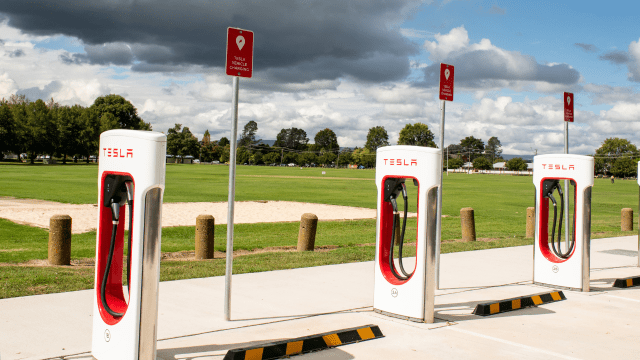There are hundreds of electric car charging stations across Australia, with some part of major networks, some costing the user per kWh and some capable of super-fast charging.
You might be thinking about where you can get a charge in Australia – especially if you’re planning a getaway.
Have no fear, because we’re here to let you know about every electric car charging location in Australia, state by state.
Every electric car charging station in Australia
Below, you’ll find every electric car charger in Australia, condensed into one easy-to-use dynamic map, powered through Plugshare.com and Google Maps. This is a user-generated map that dots out all the charging stations in Australia, so if the map is missing a charger, you can go right ahead and add it in yourself. Plugshare’s community is made up of dedicated EV drivers and right now it’s one of the best resources on EV charging locations.
You’ll notice we haven’t put every electric car charging station in Australia into one big list. That’s because it would be an enormous list and, frankly, charging stations are currently in an awkward position in Australia where there are too many to list but not enough to generally say, “There’s one nearby”.
This will definitely change over the next decade, with companies like Ampol flicking on chargers, and especially with government support.
What are the different types of electric vehicle charging ports?
The below image is from Zap Map, detailing the differences between commonly available EV chargers.

In Australia, you’re most likely to come across CCS and Type 2 chargers, along with the CHAdeMO port type. It’s likely that you’ll come across other port types in Australia, although for the most part, this is what you’ll see in Australia.
Can any EV use any EV charging station?
For the most part, as long as you’ve got a compatible port on your electric car, you should be able to get a charge from a public charging station. However, know that this can vary from charging station to charging station. At the moment in Australia, Tesla vehicles are able to use any Type 2 charging station, however, a non-Tesla EV can’t use a Tesla charging station at the moment, despite speculation that this will soon change in the U.S..
Where are electric car charging stations typically?
You’ll typically find an electric car charging station beside the road at a designated charging bay or in designated charging areas at shopping centre car parks. You’ll also typically, as an electric car owner, have a charging cable at home.
In the future, it’s likely EV charging stations will operate somewhat like modern petrol stations, but we’re just not there yet. At the moment, most public EV chargers are comprised of two car parks and a single charging station.
Do electric car charging stations cost money?
It varies from station to station. Some EV charging stations will have you spend $10 for a single recharge, some charge by the kWh, whereas others have you pay for the time you use the station. Some are also free, but it’s unlikely to stay that way forever.
- Tesla superchargers cost 51c per kWh to charge with, although some locations charge per minute. Although destination chargers have long been free, you may have to pay to use them in the future.
- Evie chargers cost 60c per kWh when using a 350kW charger and 40c per kWh when using a 50kW charger. Pricing may differ depending on the station.
- NRMA chargers are free at the moment, however they will cost non-members “within the next year”, as per NRMA group CEO Rohan Lund on The Driven podcast.
- Jolt chargers cost between 50c and 60c per kWh depending on the charging station, although users get 7kWh free per day.
- The new Ampol EV chargers cost 60c per kWh.
- Chargefox EV chargers cost 60c per kWh.
This is a snapshot of EV charging station costs from some of the larger networks, but you can find more on the Electric Vehicle Council website.
How do electric car charging stations work?
Once you’ve parked your EV at the station, you simply plug the provided plug (or your own provided plug, if necessary) into the charging port of your car and let it charge up.
It’ll usually make an engaging noise to notify you it’s working, and if you have to pay, you’ll typically have to do so before using the machine.
Once you start to surpass higher battery percentages (such as 80 per cent and 90 per cent) the charging will get slower, but eventually, it will top up completely if you’d like. It’s often recommended to not 100 per cent charge the battery of your EV to save battery life.
How long do EVs take to charge?
It depends on the power supply and the demands of the electric car. Chargers in the home usually take between five and 24 hours to charge (depending on how low your battery is), whereas established chargers available to the public can take between 10 minutes and several hours for a full charge. It’s an area where petrol cars have an obvious advantage, however, technology is improving over time.
EV manufacturers, such as Tesla and Polestar, often sell EV chargers on their websites, in case you’re after a faster charger or a backup.
We recommend using this EV charging calculator if you’re after a more precise estimate.
How far can an EV travel?
Electric cars vary greatly in terms of range. While the Nissan Leaf can travel about 170km without depleting its battery, the Tesla Model S can reach about 500km.
If you’re thinking of travelling over long distances, it’s best to know the limits of your car and the location of any electric car charging stations along the way.

Comments